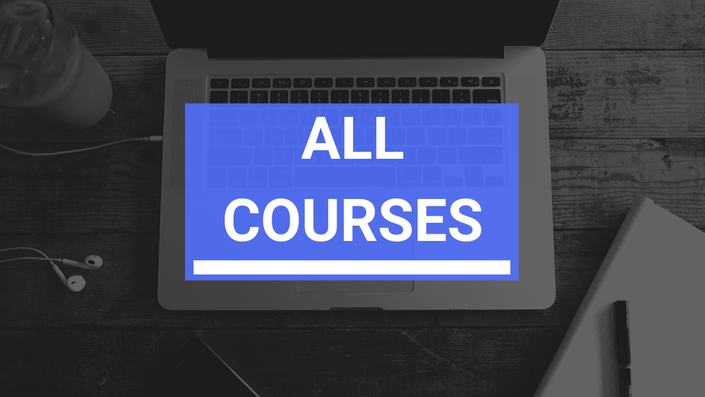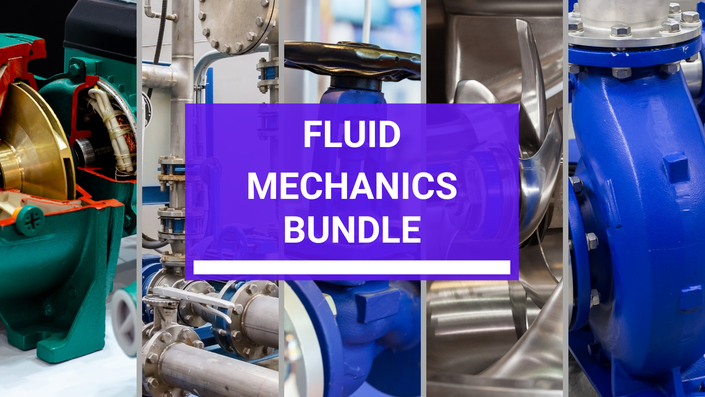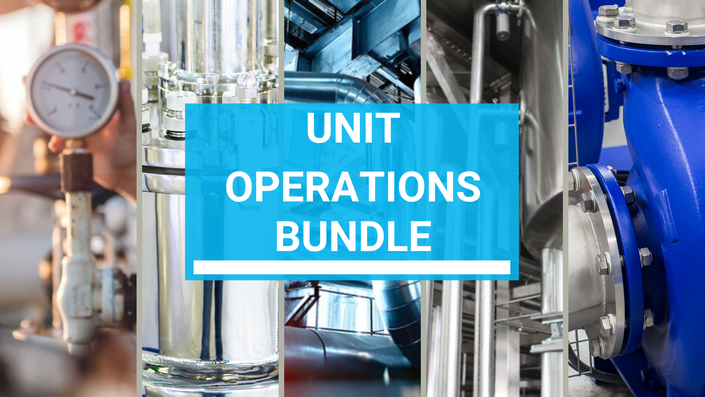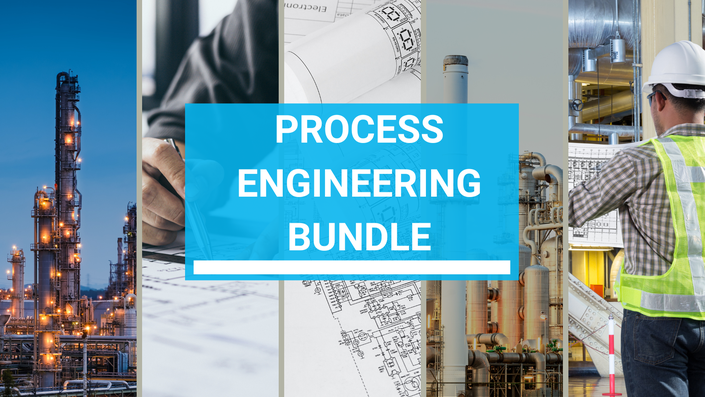Course Trailer
About this Course
📚 This Pump Fundamentals: Design, Selection & Operation course covers the essential principles of pump design, selection, and operation, helping you understand how to optimize pump performance and reliability in industrial systems. You will learn how to design and select the right pumps for various applications, ensuring efficiency, cost-effectiveness, and long-term operational reliability in chemical and process engineering systems.
Key topics covered include:
- Pump Types and Applications
- Basic Pump Design Principles
- Pump Selection Criteria (Flow Rate, Head, Efficiency)
- Pump Performance Curves and System Curves
- Pump Cavitation, NPSH (Net Positive Suction Head)
- Maintenance and Troubleshooting of Pumps
👨🏫 Designed for
Chemical engineers, process engineers, equipment designers, and maintenance professionals who need to understand the fundamental principles of pump design, selection, and operation for industrial applications.
📚 Course Approach
This course offers a balance of theory and practical application, with detailed explanations of pump fundamentals, hands-on exercises for pump selection and performance evaluation, and real-world case studies for troubleshooting and maintenance.
🎯 By the end of the course, you will be able to:
- Understand the fundamental principles of pump design and operation
- Select the appropriate pump for various industrial applications
- Analyze pump performance curves and system curves
- Optimize pump selection based on efficiency, head, and flow rate requirements
- Troubleshoot and maintain pumps to ensure reliability and longevity
🚀 Recommended for
Students and professionals in chemical engineering, process engineering, and equipment design who want to master the core principles of pump design, selection, and operation.
✅ You’ll learn to:
- Identify different types of pumps and their applications
- Select pumps based on system requirements, including flow rate and head
- Use pump performance curves to assess system compatibility
- Prevent and resolve issues such as cavitation and low NPSH
- Maintain and troubleshoot pumps to improve efficiency and reliability in systems

Self-Paced, Dynamic Lectures
Learn at your own pace, anytime and anywhere.
The lectures are concise, engaging, and focused—designed to maximize your understanding efficiently.

Downloadable Material
Get access to all simulation files, workshop materials, spreadsheets, reference guides and companion E-Book.
Use them to practice offline, follow along with lessons, or revisit concepts anytime.

Evaluations, Quizzes
Evaluate your progress through interactive quizzes and self-assessments.
Reinforce key concepts, identify gaps, and ensure you're ready to apply what you've learned in real scenarios.

30 Day Money-Back Warranty
Enroll with confidence—if the course doesn’t meet your expectations, you can request a full refund within 30 days.
No questions asked.

Certificate of Completion
Receive an official certificate or diploma once you finish the course—perfect for showcasing your new skills on your resume, LinkedIn, or job applications.

Instructor Support
Get guidance whenever you need it—ask questions, request feedback, and interact directly with the instructor throughout the course.
Curriculum
- Introduction to Section 1: Basic Pump Operation, Calculations & Performance Indicators (1:26)
- Rotatory Equipment vs. Pumps (4:04)
- What is a Pump? How do they work? (4:50)
- Pumps Available Online (4:20)
- Common Parts of a Pump (4:00)
- Pump Equations - Overview (11:45)
- What is Pump Head? (19:38)
- Introduction to Pump Exercises (5:08)
- Ex. 1 Application of M.E.E. with NO Pump (7:22)
- Ex. 2 Application of M.E.E. with a Pump (9:38)
- Pump Power Supply (5:58)
- Efficiency of a Pump (2:27)
- Ex. 3 Efficiency of a Pump & Power Supply (1:29)
- Ex. 4 More on Pump Power & Liquids (1:39)
- Ex.5 Pumping Power in U-Shaped Pipeline (8:42)
- More Practice for M.E.E. and Pumps (0:31)
- Ex. 6 Pumping Requirment for Pressurized Tank System (4:32)
- Ex. 7 Head & Pumping Requirement for a Tank System (2:43)
- Ex. 8 - Sump Pump Calculations (6:00)
- Ex. 9 Submersible Pump in a Deep-Well (7:27)
- Ex. 10 Pump Assessment & Power Calculations for Water System (6:05)
- Ex.11 Coolant Distribution & Pump Head Requirements (7:35)
- Ex. 12 Pump Requirements by the Liquid System (10:20)
- Ex. 13 Automotive Fuel Pump Calculations - Power & Efficiency (7:57)
- Ex. 14 ANALYSIS - Power Requirment for a Motor (6:09)
- Ex. 15 ANALYSIS: Power Conveyed by the Oil to the Fluid (5:48)
- Ex. 16 ANALYSIS Pressure Calculations for a Kerosene System (6:27)
- Ex. 17 ANALYSIS Max. Height for a Liquid to Avoid Cavitation of a Pump (5:44)
- Recommended Course - Mastering Centrifugal Pumps (0:35)
- What Is a Pump Performance Curve? How to Create Them? (18:48)
- Pump Performance Diagrams - What are they? (11:58)
- How to Read Pump Curves (Impeller Size, Head, Flow Rate, Efficiency, Speed, Power, NPSH & More!) (13:20)
- Ex. 18 How to Read Pump Curves - Maximizing Efficiency of a Pump (1:30)
- Ex. 19 How to Read Pump Curves - Identifying a Pump (1:57)
- Ex. 20 How to Read Pump Curves - Minimum Flow Rate given a NPSH (1:19)
- Introduction to Pump Performance Indicators (2:50)
- Common Pump Performance Indicators (3:16)
- Pump Cavitation - What is it? (9:41)
- Net Positive Specific Head Required and Available (7:58)
- Calculations - Net Positive Specific Head Required and Available (8:59)
- NPSH Exercises - How to Approach Them (1:27)
- Ex. 21 Simplified Calculations of NPSHA for Benzene (3:15)
- Ex. 22 Simplified Calculations of NPSH available for a Coolant (low volatility) (1:45)
- Ex. 23 Complete Calculations for NPSHA in a Tank-Pump System (2:24)
- Ex. 24 Lower Tank System Calculations for NPSH (1:48)
- Ex. 25 Calculations of NPSH for Pressurized Systems (3:56)
- Ex. 26 Recalculations of NPSHA for a Pump BELOW inlet (2:48)
- Ex. 27 NPSH Calculations Given Friction Losses (4:43)
- Specific Speed, NS (4:28)
- Suction Specific Speed, Nss (3:00)
- Section 1 - Closure (1:28)
- Evaluation - Section 1
- Introduction to Section 2: Common Types of Pumps (0:47)
- Positive Displacement Pumps - Their Nature & Generalities (7:24)
- Positive Displacement Pumps: Types, Advantages & Disadvantages (5:04)
- Case Study: Gear Pumps (14:14)
- Recommended Course: Types of Pumps (1:10)
- Kinetic/Dynamic Pumps (4:29)
- Kinetic/Displacement Pumps - Advantages, Disadvantages, Industrial Applications & More (5:44)
- Case Study: Centrifugal Pumps (19:52)
- Other Type of Pumps (9:24)
- Closure - Section 2 (0:32)
- Evaluation - Section 2
- Introduction to Section 3 - Overview of Methodology (0:57)
- Overview of Pump Selection Methodology (1:40)
- The System Head (8:55)
- Ex. 28 System Head Calculation (4:50)
- Ex. 29 System Head (Spreadsheet) Calculation (27:50)
- The System Curve (5:19)
- Ex. 30 System Curve - Open Tank (Spreadsheeting) Calculations (7:14)
- Ex. 31 System Curve - Pressurized Tank (Spreadsheeting) Calculations (10:34)
- Ex. 32 System Curve - Throttling Valves (6:31)
- Ex. 33 System Curve Analysis - Effect of Valves (1:59)
- Ex. 34 System Curve Analysis - Impeller Diameter (2:01)
- System Curve Analysis (1:19)
- Comparing: System Curve vs. Pump Curve (2:11)
- Pump Selection Criteria (4:44)
- Lifecycle (Economics & Finances) (2:03)
- Steps in Pump Selection (1:41)
- Step 1 of 5 - General Pump Selection Diagram (Theory + Exercise) (6:06)
- Step 2 of 5 - Pump Supplier's Family - Select Best Operation Point (Theory + Exercise) (6:20)
- Important Note: Suction & Discharge Lines (2:35)
- Step 3 of 5 - Calculate & Adjust System Head (2:35)
- Step 4 of 5 - Select Operation Point (Intersect System and Pump Curves) (1:54)
- Step 5 of 5 - Optimizing the Operation Point (2:08)
- Ex. 36 Step 5 of 5 - Optimizing the Operation Point (15:58)
- Summary - Pump Selection Methodology (1:28)
- FINAL PROJECT - Case Study: Pump Selection (38:46)
- Closure - Section 3 (0:39)
- Evaluation - Section 3
Course Enrollment
This and all other courses are available only via the All Courses - One Subscription Membership.

Hi, I’m Emmanuel Ortega,
a.k.a. the Chemical Engineering Guy!
With five years in the chemical industry, from petrochemical plant design to polyester textiles, I bring real-world experience to show the true value of engineering knowledge.
My Expertise:
- Process Simulation & Optimization
- Chemical Process Design
- Process Equipment Design
- Automotive & Industrial Polyester Yarn Technologies
- Online Tutoring, Online Education Management
The Courses I design are entirely dynamic. You will see theory and then apply it ASAP to a real life problem! I even use the books you are using right now in your engineering courses...
I'll see you in class!
Frequently Asked Questions (FAQ)
- When does the course start and finish?
- The course starts now and never ends! It is a completely self-paced online course - you decide when you start and when you finish.
- How long do I have access to the course?
- *How does lifetime access sound? After enrolling, you have unlimited access to this course for as long as you like - across any and all devices you own.
- NOTE*: This is true as long as you keep your subscription active.
- What if I am unhappy with the course?
- We would never want you to be unhappy! If you are unsatisfied with your purchase, contact us in the first 30 days and we will give you a full refund.
- Will I Get a Certificate/Diploma of Completion?
- Yes! After the course, you will get a Certificate of Completion with a Diploma! You can use this in your Resume!
- Are Resources Downloadable?
- Absolutely YES! Every resource is available for download, allowing you to study alongside them.
- Any doubt? Message me!
- Please reach out! [email protected]




